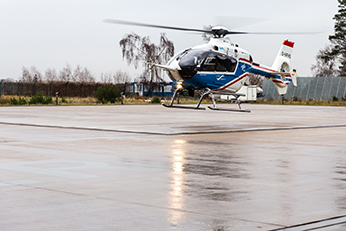ROTORCRAFT USING POINT-IN-SPACE NAVIGATION FLY SAFER ROUTES
Helicopters frequently operate in difficult terrain and at different speeds to other airspace users. Procedures to help pilots navigate more accurately improve safety by reducing workload and providing more flexibility. By introducing advanced approach and departure procedures in the terminal manoeuvring area (TMA), SESAR demonstrates how point-in-space (PinS) approaches based on augmented GNSS signals result in more flexible approach paths, including curved approach segments. Pilots benefit from easier access to final approach and take-off points while reducing the potential impact on other airspace users. The approach and departure paths can connect with the low-level instrument flight rules (IFR) route network, if present, and can include curved procedures in the initial, intermediate, final and missed approach segments.
The solution also contributes to reduced noise footprint and improved access to final approach and take-off points with vertical guidance. This is in addition to the safety benefits of reducing the use of visual flight rules (VFR) in marginal conditions, particularly low-visibility.
SESAR partners carried out three validation exercises including a real-time validation followed by flight trials at an airport and heliport in VFR and IFR conditions. An optional head-mounted display was also used by pilots and this further improved situational awareness. The scenarios included assessment of the navigation performance, human factors and crew workload. Using PinS approaches enabled the helicopters to fly with greater accuracy and more flexibility in dense and constrained airspace and resulted in low crew workload during the RF segments.
This operational improvement builds on already mature SESAR 1 standard PinS by adding more advanced procedures, such as curved approaches. It enables pilots to fully utilise rotorcraft performance while reducing fuel use and noise emissions. The head-mounted display further enhances safety by increasing situational awareness. The solution is applicable to IFR certified rotorcraft with advanced navigation performance capability, has no impact on ground infrastructure and conforms with ICAO procedures for air navigation services.
The findings recommend introducing rules to promote IFR operations for helicopters, along with exploration of alternative satellite navigation services in the event of GNSS loss or jamming.
The solution is available for industrialisation.
BENEFITS
Improved pilot situational awareness
Enhanced safety
Reduced fuel burn
Improved access and equity for rotorcraft users

DATAPACKS
SESAR Solution PJ01-06 Contextual Note (15December2019)
D5.1.010 PJ01-06 EAD - SPR-INTEROP OSED V3 Part I v00.04
D5.1.010 PJ01-06 EAD - SPR-INTEROP OSED V3 Part II SAR v0
D5.1.010 PJ01-06 EAD - SPR-INTEROP-OSED V3 Part IV - HPAR
D5.1.010 PJ01-06 EAD - SPR-INTEROP-OSED V3 Part V
D5.1.040 PJ01-06 EAD - CBA V3 v00.06.00 (21October2019)
D5.1.050 PJ01-06 EAD - TS IRS V3 v00.04.00 (25November2019)
